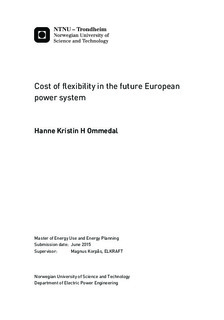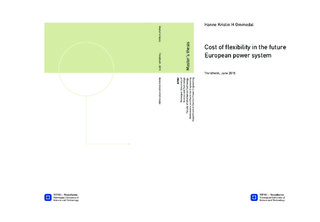| dc.description.abstract | Commitments from the European energy and climate of 20 per cent renewable energy share in the energy generation system by 2020 and a 85 to 90 per cent reduction in greenhouse gas emissions in 2050 entails a higher penetration of non dispatchable renewables like solar and wind in the future European energy system.
For the electricity system to guarantee equilibrium between generation and consumption, flexible generation units are necessary to cover unpredictable periods with small amount of wind and cloudy hours. The best alternatives for flexible generation comes from hydropower, pumped storage hydropower (PSHP) and gas fired power plants. Coal fired and nuclear technology seems not to deliver the flexibility necessary, and are also less cost efficient when a lower load factor situation might be the future for conventional technologies.
This report presents a levelized cost of electricity (LCOE) study. LCOE is a convenient measure that summarize the overall competiveness of several different generating technologies. For this analysis, a spreadsheet model has been made, both for the purpose of this thesis and for general use. The report and the model provides simple clear metrics based on up-to-date information and future scenarios from reliable sources. All the collected data are used to evaluate both costs and performances of different conventional technologies, and their ability to act as a flexible resource in the energy mix for upcoming years. To account for the development of fuel price and carbon taxes, International Energy Agency (IEA) has predicted scenarios that are included in the model. The report is a supplement to the large debate of renewable power generation and the need of more available flexible generation. This study will hopefully assist key decision makers to make the right choice in policy and investment.
In general, Norwegian hydropower and PSHP turns out to offer the lowest LCOE in most scenarios. For a closer comparison between some of the most flexible generation sources, a case study with a load factor of typically 0.3 and central values for pumping price, capacities and investment cost shows a LCOE of 51.1 for hydropower, 77.2 /MWh for PSHP, 118.8 /MWh for CCGT and 153.6 /MWh for CCGT w. CCS. The results seems to be promising for PSHP development. However, PSHP and hydropower proves to be sensitive to parameter values and discount rate. Hence, it will be of a higher risk to invest in PSHP than for example gas fired technology.
The Norwegian hydro generating facilities needs transmission connection to reach the continent, while gas and coal fired power plants may, in theory, be placed wherever in Europe without any extra large transmission or grid related costs. When adding Statnett s share of the Nord.Link project, and the estimated cost of grid upgrades necessary to Norwegian hydropower and PSHP, the LCOE becomes 64.4 /MWh for hydropower and 99.1 /MWh for PSHP. Simply, the rich hydro resources from Scandinavia is definitely of the better economical options, even with the high additional share of costs related to transmission and grid upgrades.
This study shows that the investment of transmission connection between Norway and the European continent will give several benefits. The PSHP seems to offer the required ancillary services needed when a larger share of intermittent renewables will take part of the future European energy system. Several sources claims Norwegian PSHP will have a decisive role in the future, offering valuable flexibility to the European power system. | |

